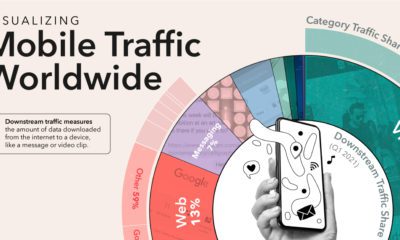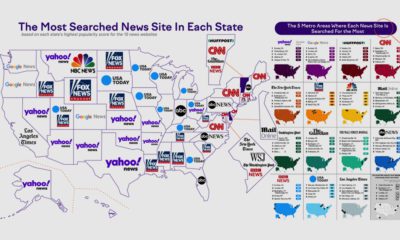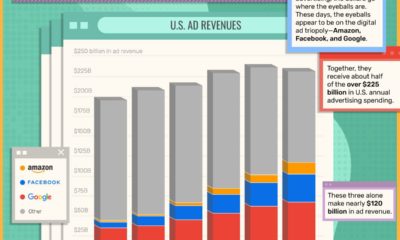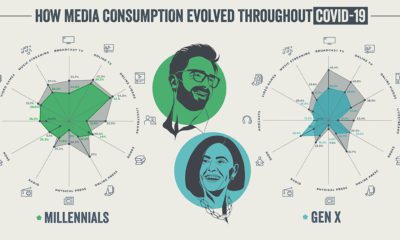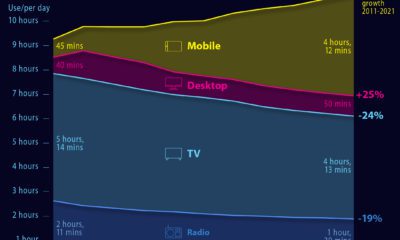The Advertising Revolution
Sponsored by: Market One Media Group Many decades ago, the world was much simpler for advertisers. Buying a ½ page newspaper ad or a 30-second television spot reached thousands of people, and consumers weren’t oversaturated with ads. Today, we are bombarded with over 5,000 brand exposures each day. Of those, 362 are advertisements with only 12 of them “making an impression” on us. Here’s a breakdown of average exposure per day:
Average number of advertisement and brand exposures per day per person: 5,000+ Average number of “ads only” exposures per day: 362 Average number of “ads only” noted per day: 153 Average number of “ads only” that we have some awareness of per day: 86 Average number of “ads only” that made an impression (engagement): 12
With this oversaturation of the traditional ad market, the concept of “native ads” has emerged.
Native Ads
Native advertising is paid content that is created to fit the same format as a publisher’s organic content. In other words, it shows up to regular viewers as “sponsored” or “paid” posts in the same streams as regular content. Native ad spending has exploded, and from 2013 to 2018, the industry is expected to quadruple in size. There are compelling statistics for both the audience and advertisers on native ads: Audience:
70% of individuals want to learn about products or content through content rather than traditional advertising. 32% of consumers said, when given a choice, that they would rather share a native ad with friends and family vs 19% for banner ads. 57% of publishers have a dedicated editorial team to create content readers will care about, leaving publishers in full control, not brands, which ultimately benefits readers.
Advertisers:
People view native ads 53% more than banner ads. Native advertising generates up to an 82% increase in brand lift. Native ads that include rich media boost conversion rates by up to 60%. Purchase intent is 53% higher with native ads (vs. 34%) 49x higher clickthrough rate, 54% lower cost-per-click
New Media
Native ads are also being used by many of the “new media” and adtech companies that have had very successful fundraising rounds: Vice Latest raise: $250 million (2014) Led by: A+E Networks Valuation: $2.5 billion AppNexus Latest raise: $62.7 million (2015) Valuation: $1.2 billion Vox Latest raise: $200 million (2015) Led by: NBC Universal Valuation: $850 million Buzzfeed Latest raise: $200 million (2015) Led by: NBC Universal Valuation: $1.5 billion
The Future of Native Advertising?
Right now 41% of brands use native advertising as part of their marketing mix, but the shift is only beginning. Here’s what experts think the future of native holds: Tessa Gould, Director of Native Ads Products, The Huffington Post “Next for native is being able to use other ad technologies to make native smarter. At the moment everyone is creating content and talking about social actions. But how do you go about retargeting the people who view the native ad elsewhere with banner ads and actually converting them into customers?” Audra Martin, VP of Advertising, The Economist Group “As publishers start to educate brands more and agencies more, the content will just get better. Then distribution, in terms of getting more sophisticated, not in terms of fooling readers but making it relevant to readers in the right place at the right time.” Steve Edwards, Digital Sales Director, Hearst UK “My main thing is about control. Native will continue to develop along the lines it has. Increasingly it’s about publishers taking control of the message and advertisers and brands coming along with us. Getting distribution right and getting measurement metrics right, how we actually measure success. How we can create work that is as good as the editorial that surrounds it. Take the logo off it, does it still work? That’s really interesting for us, and we’ve still got a way to get there.” Sebastian Tomich, VP of Advertising, The New York Times “Brands are jumping into native because they feel like they should be.” on Even while political regimes across these countries have changed over time, they’ve largely followed a few different types of governance. Today, every country can ultimately be classified into just nine broad forms of government systems. This map by Truman Du uses information from Wikipedia to map the government systems that rule the world today.
Countries By Type of Government
It’s important to note that this map charts government systems according to each country’s legal framework. Many countries have constitutions stating their de jure or legally recognized system of government, but their de facto or realized form of governance may be quite different. Here is a list of the stated government system of UN member states and observers as of January 2023: Let’s take a closer look at some of these systems.
Monarchies
Brought back into the spotlight after the death of Queen Elizabeth II of England in September 2022, this form of government has a single ruler. They carry titles from king and queen to sultan or emperor, and their government systems can be further divided into three modern types: constitutional, semi-constitutional, and absolute. A constitutional monarchy sees the monarch act as head of state within the parameters of a constitution, giving them little to no real power. For example, King Charles III is the head of 15 Commonwealth nations including Canada and Australia. However, each has their own head of government. On the other hand, a semi-constitutional monarchy lets the monarch or ruling royal family retain substantial political powers, as is the case in Jordan and Morocco. However, their monarchs still rule the country according to a democratic constitution and in concert with other institutions. Finally, an absolute monarchy is most like the monarchies of old, where the ruler has full power over governance, with modern examples including Saudi Arabia and Vatican City.
Republics
Unlike monarchies, the people hold the power in a republic government system, directly electing representatives to form government. Again, there are multiple types of modern republic governments: presidential, semi-presidential, and parliamentary. The presidential republic could be considered a direct progression from monarchies. This system has a strong and independent chief executive with extensive powers when it comes to domestic affairs and foreign policy. An example of this is the United States, where the President is both the head of state and the head of government. In a semi-presidential republic, the president is the head of state and has some executive powers that are independent of the legislature. However, the prime minister (or chancellor or equivalent title) is the head of government, responsible to the legislature along with the cabinet. Russia is a classic example of this type of government. The last type of republic system is parliamentary. In this system, the president is a figurehead, while the head of government holds real power and is validated by and accountable to the parliament. This type of system can be seen in Germany, Italy, and India and is akin to constitutional monarchies. It’s also important to point out that some parliamentary republic systems operate slightly differently. For example in South Africa, the president is both the head of state and government, but is elected directly by the legislature. This leaves them (and their ministries) potentially subject to parliamentary confidence.
One-Party State
Many of the systems above involve multiple political parties vying to rule and govern their respective countries. In a one-party state, also called a single-party state or single-party system, only one political party has the right to form government. All other political parties are either outlawed or only allowed limited participation in elections. In this system, a country’s head of state and head of government can be executive or ceremonial but political power is constitutionally linked to a single political movement. China is the most well-known example of this government system, with the General Secretary of the Communist Party of China ruling as the de facto leader since 1989.
Provisional
The final form of government is a provisional government formed as an interim or transitional government. In this system, an emergency governmental body is created to manage political transitions after the collapse of a government, or when a new state is formed. Often these evolve into fully constitutionalized systems, but sometimes they hold power for longer than expected. Some examples of countries that are considered provisional include Libya, Burkina Faso, and Chad.



